How many of these Types of Monstera do you know? Stay tuned for the best Monstera varieties for an instant green appeal!
If you want a houseplant that offers an eye-catching appearance with fancy foliage, then pick one out from the best Types of Monstera that we have for you!
Best Monstera Varieties
1. Borsigiana
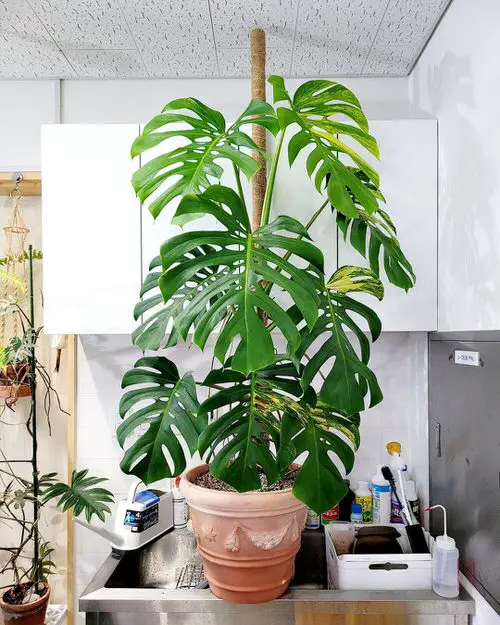
Botanical Name: Monstera borsigiana
Borsigiana has a vining growth pattern with long stems. Its smaller, heart-shaped leaves set it apart, and distinguishing it from other Monsteras is easy.
Tip: If you find it difficult to differentiate between deliciosa and borsigniana, simply look for the patterns. Delisiosa has a clean pattern, and borsigniana shows apertures arranged in two rows.
2. Swiss Cheese Plant
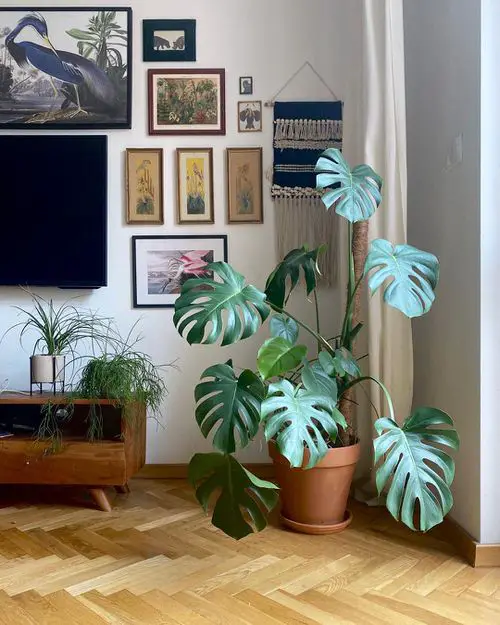
Botanical Name: Monstera deliciosa
Deliciosa is the most common variety, and just like other plants in the family, it also offers extraordinary heart-shaped dark green cut foliage. Its air-purifying qualities make it an excellent choice for indoor environments, and it’s relatively easy to care for.
3. Albo Variegata

Botanical Name: Monstera deliciosa ‘Albo Variegata’
The sheer beauty of these gorgeous and expensive types of variegated Monstera is incomparable! The variegated leaves in bright, pure white shade and green hues of the Albo Variegata look magnificent.
Note: Due to their rarity and high demand, Albo Variegata Monsteras can be quite expensive, with prices often ranging from $3,000 to $5,000 or even more, depending on the plant’s size and variegation quality. As with all rare plants, prices can fluctuate.
4. Adansonii
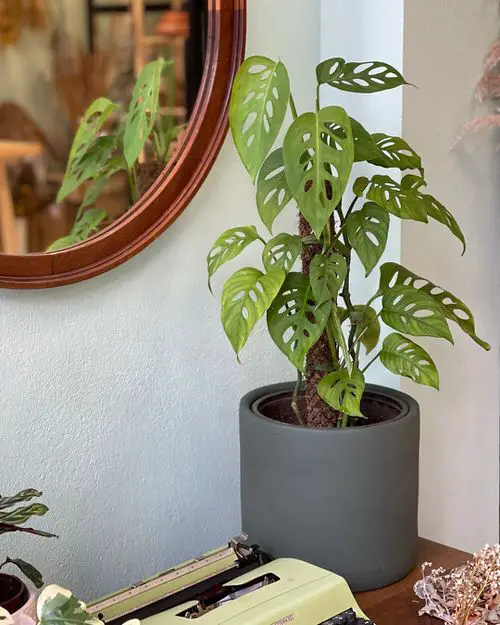
Botanical Name: Monstera adansonii
Also known as the Swiss Cheese plant, this variety is smaller than the different types of Monstera plants. It has heart-shaped dark green foliage with cuts. Some leaves are round in shape, whereas a few are narrower.
5. Dubia
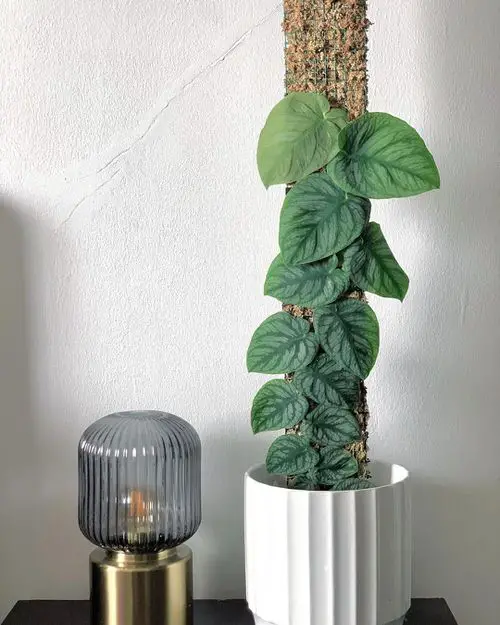
Botanical Name: Monstera dubia
Monstera dubia are also known as the ‘Shingle plant.’ They have small heart-shaped leaves patterned in light and dark green veins. Monstera dubia thrives in bright, indirect light. So avoid direct sun because it can scorch the leaves.
6. Pinnatipartita
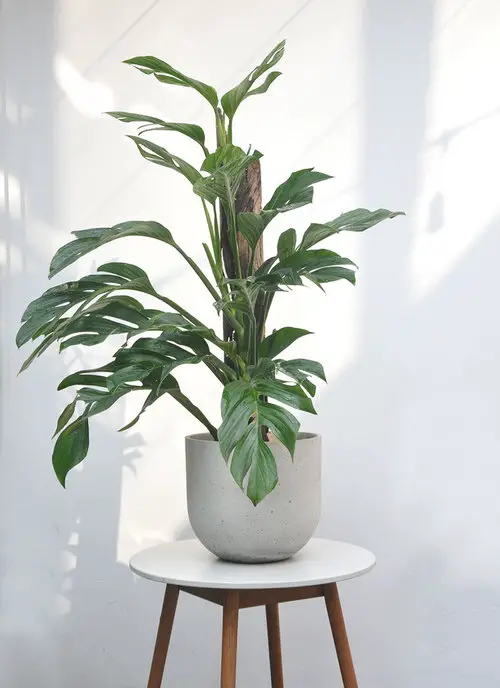
Botanical Name: Monstera pinnatipartita
Pinnatipartita is a climbing variety that changes dramatically with age. Its small leaves feature a rough texture and prominent hollow veins, creating a unique appearance.
7. Silver Monstera
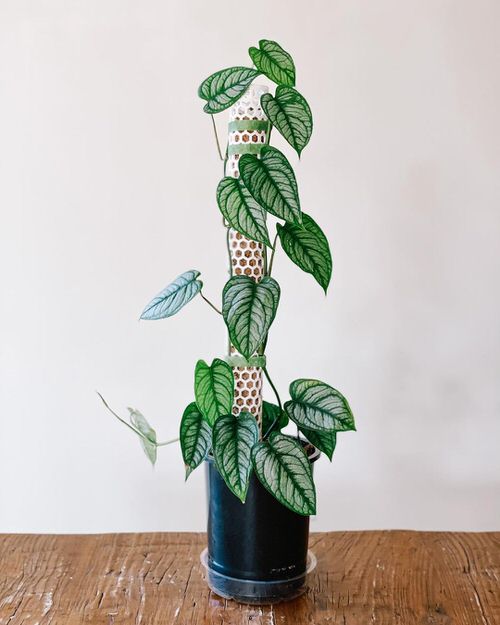
Botanical Name: Monstera siltepecana
This distinctly beautiful plant does not have leaf holes until it fully develops. The lance-shaped young leaves have a beautiful silver hue and dark green veins that earn it the name Silver Monstera.
8. Obliqua

9. Thai Constellation
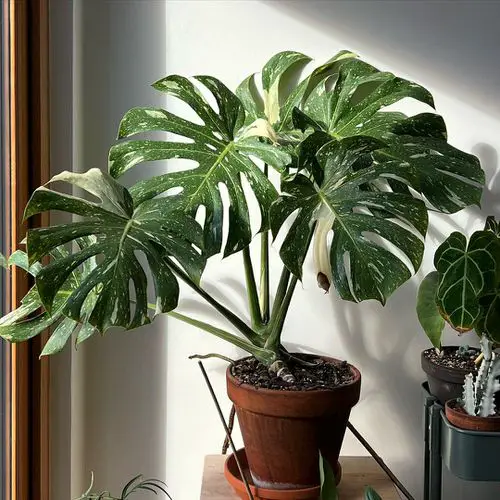
Botanical Name: Monstera deliciosa ‘Thai constellation’
One of the prettiest varieties, Monstera Thai constellations have cuts and patterns on white-cream and green foliage. They can achieve a good height, growing up to 4-6 feet tall indoors.
Note: The Thai Constellation is another highly sought-after variety, known for its beautiful creamy variegation. It is a premium plant, but its price point is usually more accessible than the Albo Variegata, typically around $300, though this can vary.
10. Karstenianum
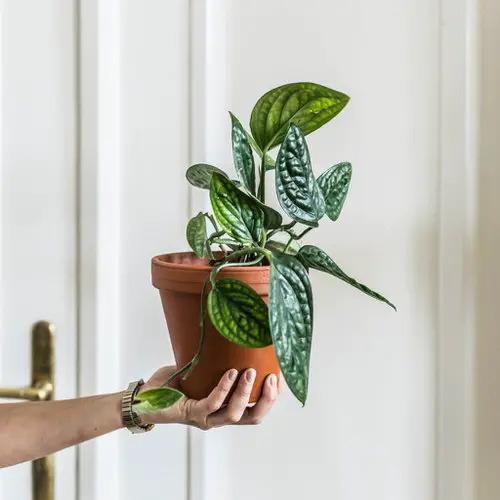
Botanical Name: Monstera karstenianum
Karstenianum Monsteras are also known as Monstera Peru. They feature leathery medium green leaves that mature to a deep green hue with lacy veins that resemble a spiderweb. The grooves make them look gorgeous.
11. Borsigiana Variegata
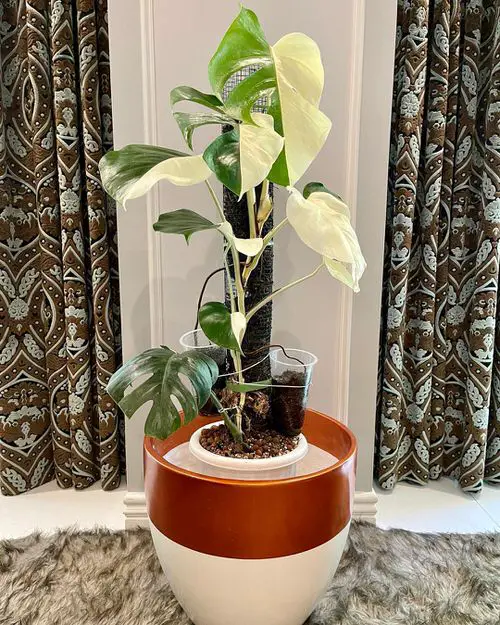
Botanical Name: Monstera borsigiana variegata
The Borsigiana Variegata is just like the Borsigiana–but with a slight twist. The foliage is bright green and creamy white. Plus, it can easily reach up to 6 feet tall indoors.
Note: This one shares the same high price points as the Albo Deliciosa. The term ‘half moon albo’ is a common term to describe a leaf that has half-green and half-white variegation. So a Borsigiana Variegata with a lot of this type of variegation will be very valuable.
12. Split Leaf Philodendron
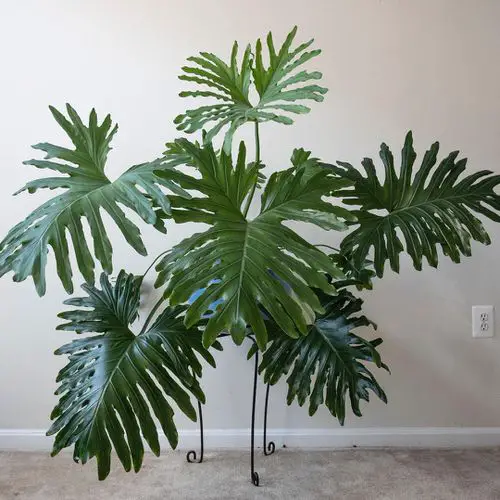
Botanical Name: Philodendron bipinnatifidum
The split-leaf Philo gets a place on this Monstera philodendron types list because it looks a lot like Monstera, thanks to the cut foliage. It is a great houseplant and is absolutely stunning.
Note: The Split Leaf Philodendron, while resembling a Monstera, is not a true Monstera species. We’ve included it in our monstera plant types list due to its visual similarity.
13. Mini Monstera
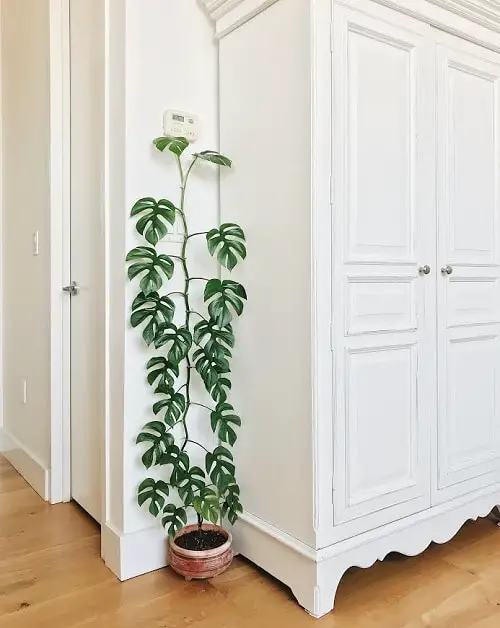
Botanical Name: Rhaphidophora tetrasperma
The Mini Monstera is not massive like the others. Its slender, lance-like leaves are really cute, but it tops out at 6-8 feet.
Note: While the Mini Monstera resembles a Monstera in appearance, it is not a true Monstera but a member of the Rhaphidophora genus. Despite its similarities to Monsteras, it belongs to a different botanical group and showcases distinct growth patterns and characteristics. Here are more of such varieties!
14. Acuminata
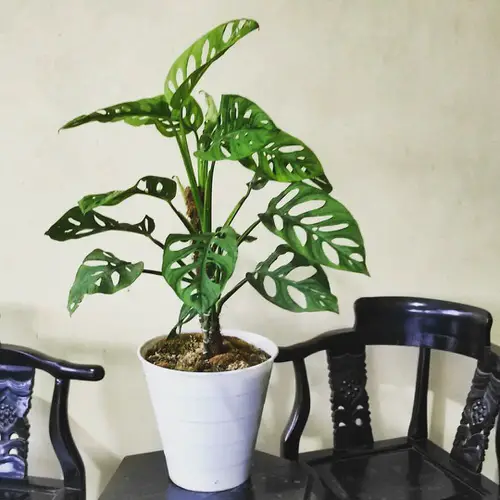
Botanical Name: Monstera acuminata
Monstera Acuminata is considered to be the smaller cousin of Monstera Adansonii. Unlike the classic Monstera, the Acuminata’s leaves don’t have large splits or fenestrations when juvenile.
15. Esqueleto

Botanical Name: Monstera epipremnoides ‘Esqueleto’
You might also know the Esqueleto as the Skeleton Monstera. It is so named because its fenestrations are so prominent, and the leaves look like a skeletal structure. It can be a great focal point for home.
16. Standleyana
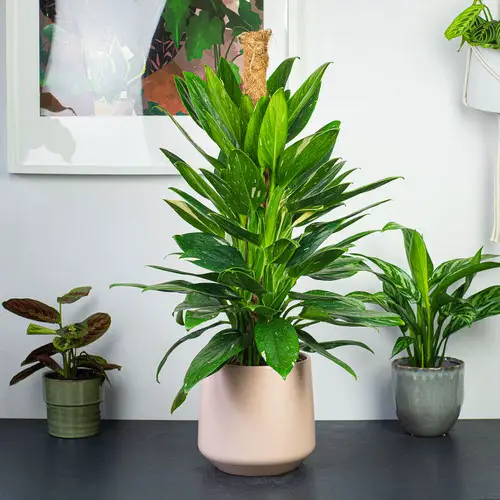
Botanical Name: Monstera standleyana
Monstera Standleyana originally comes from Columbia and Central America, and it is a delightful species to have at home. It forms beautiful, lance-shaped leaves that are often covered in white spots.
17. Subpinnata

Botanical Name: Monstera subpinnata
Monstera subpinnata is native to Colombia and Bolivia. It does not look like regular Monsteras and is more like a palm. It is a vigorous climber that can grow up to 39 feet tall outdoors.
18. Dissecta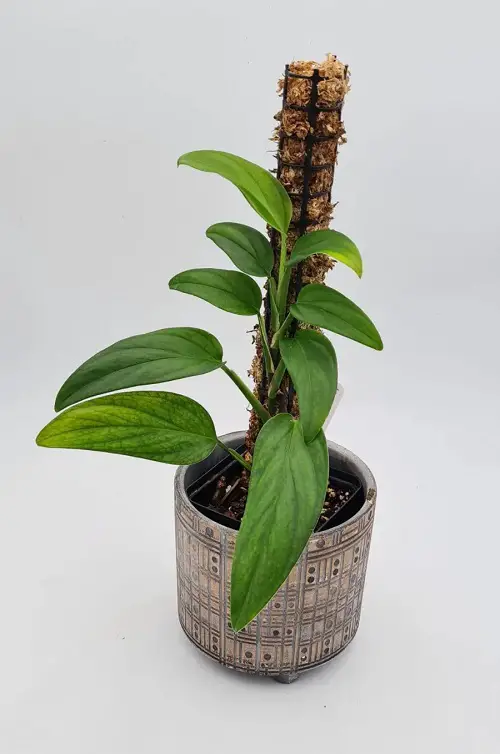
Botanical Name: Monstera dissecta
Speaking of unique monsteras, Monstera dissecta has dull green leaves that have dark green veins. It’s also called Lacy Tree Philodendron and develops fenestrations as it matures. If you find one of these, don’t miss out because it’s really rare.
19. Sierrana
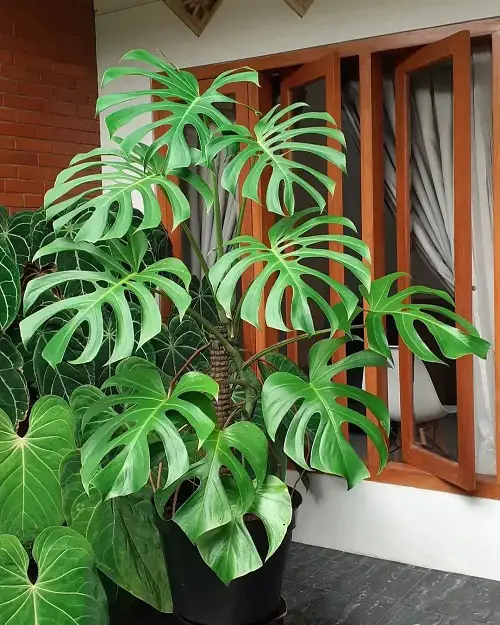
Botanical Name: Monstera sierrana
The Monstera Sierrana was discovered in in the Sierra Juarez mountain range of Oaxaca, Mexico, in 1961. The leaves are smaller than Monstera deliciosa and have deeper cuts reaching toward the midrib.
20. Spruceana

Botanical Name: Monstera spruceana
Monstera Spruceana is like most other Monsteras, but the fenestrations it has extend so much that they divide the leaf and make it appear cut.
21. Lechleriana

Botanical Name: Monstera lechleriana
Monstera lechleriana has massive leaves, but the fenestrations in these are not so prominent; they look like small holes have been poked through.
22. Acacoyaguensis

Botanical Name: Monstera acacoyaguensis
Monstera acacoyaguensis is often confused with the adansonii. But it has narrower leaves. Even when healthy, the leaves are loose and appear to be drooping. Plus, they’re really glossy.
What Are the Rarest Types of Monstera?
One of the rarest Monstera species is the obliqua. Monstera Variegata Albo Borsigiana is another variety that is really hard to find. Other than these two, the Siltepecana variety is also limited.
Collecting and Propagating Types of Monstera
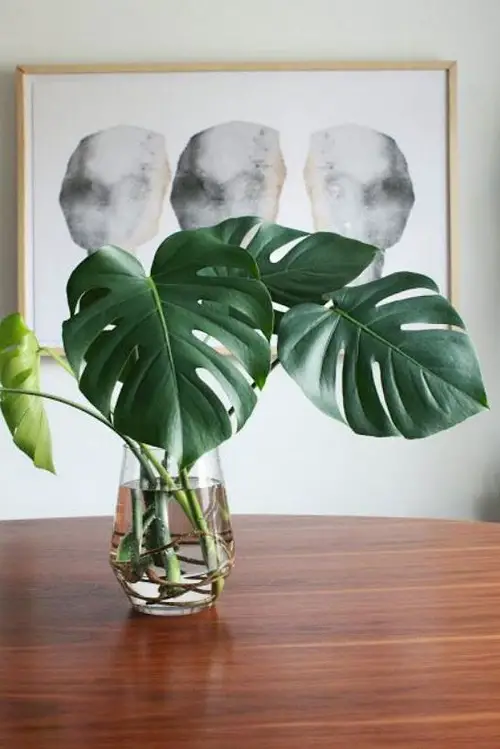
We guarantee that after reading our list, you’re really excited to get your hands on them and collect as many monsters as you can find. If you spot one of these anywhere, be it your friend’s house, or a local nursery, all you have to do is ask for one or two cuttings.
Take a healthy 4-6 inch cutting and plant it in a small pot. You can even grow them in a bowl of water. Monsteras root easily, and soon you’ll have your own. Plus, cuttings always inherit the characteristics of the parent plant, so you’ll get what you see.
Once they’ve rooted, all that’s left for you to do is transplant it in another pot and care for it.
Note: The plant market can be dynamic, especially for rare varieties like variegated Monsteras. Prices can vary significantly based on numerous factors, including plant size, variegation quality, and market demand. When dealing with rare and expensive plants, it is always best to do research from multiple, reliable sources and nurseries.



Why my monstera po is like a Pinnatipartita when I bought then suddenly it becomes Viney and the leaves are different. It it just a plain green heart shape without cuts
Its monstera karstenianum, just like mine. I’m waiting fot the leaves to split but they don’t. Yes, it’s vine and grows really fast.
I believe the splits can vary depending on the amount of light. If they’re not splitting they might not be getting enough light. (But you don’t want so much too quickly or it’ll burn)
Dear Sir,
Can I buy followings
Swiss Cheese Plant,Albo Variegata,Thai Constellation,Borsigiana Variegata,plants
I Love Monstera Acuminata,, Nice Info. Thank You for your post..
I thank you for your beautiful collections but I find it hard to purchase ALBO VARIEGE which I really love and want. Can you advise me where to purchase this plant at a less costly price I would be very grateful.
Jumanji Jon or Albo King in Pasadena, CA. If you’re not close, try the offer up app or the Blossm plant app.
Hello. I thought that I purchased an Adansonii, but now I cannot tell after seeing pictures of your Obliqua and Acuminata. How can I tell the difference?
There is no difference between Monstera Deliosa and Borgiana. The confusion came about when people grew them indoors, so the leaves never reach their full size as in the wild. According to the venerated Royal Botanic Gardens, Kew, has told us so. Monstera deliciosa is the only accepted species. Monstera borsigiana is simply a synonym and is not a distinct species. Some nurseries still label montera one or the other.
Now that you know, please update your blog so we can get rid of misinformation on the internet concerning the gorgeous big jungle leaf plant that everyone loves: MONSTERA :)
Your obliqa looks more like adonosii. Obliqa are very expensive and much finer. Many people have been sold adonosii, thinking it’s obliqa. If it’s less than a couple thousand dollars, it’s adonosii for sure!